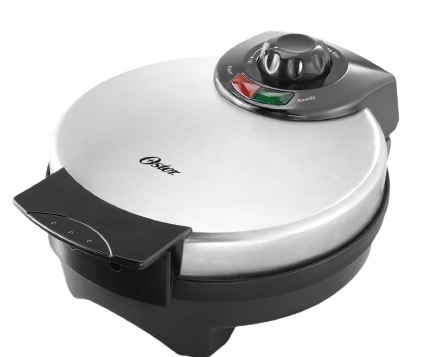Waffles, waffles, waffles! You are missing out if you haven’t had a Belgian waffle yet. It’s a fluffier version of the regular waffle, topped with delicious toppings, and can be eaten any time of day! Let’s clarify the difference between Belgian Waffle VS Regular Waffle.
If you’re a fan of waffles, you may have heard the term “Belgian waffle” thrown around. But what is it? How does it differ from regular waffles? And why should anyone care about something so seemingly innocuous?
This article will cover the basic differences between Belgian Waffles and Regular Waffles, as well as some popular recipes that use either one.
What Is A Regular Waffle?
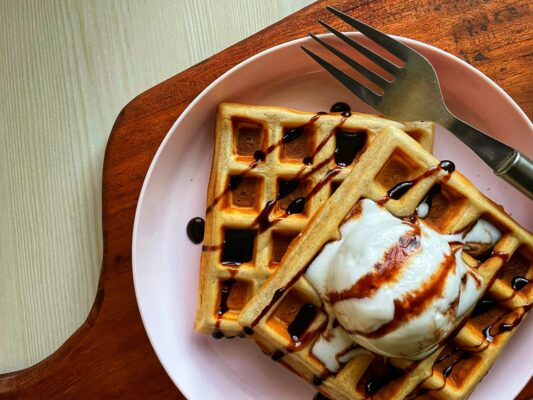
Regular waffles are different from Belgian waffles because they are made with a batter that is cooked on both sides.
Waffles are different from pancakes, which are made by flipping on both sides.
What is a Belgian Waffles?
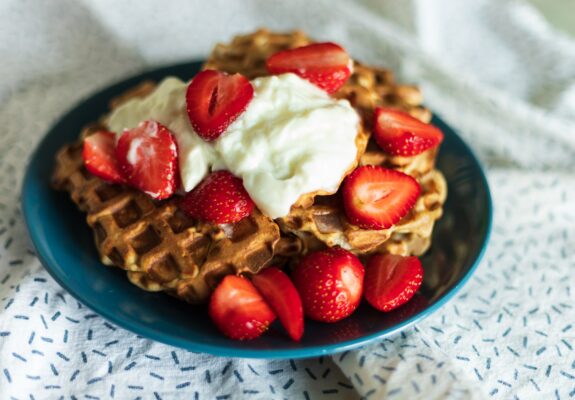
Belgian waffles are a popular breakfast food all around the world. They are made by pouring batter into a special waffle iron, which cooks the batter in a patterned manner.
The resulting waffles have many different shapes and forms, with some being more common than others.
Belgian waffles can be eaten plain or smothered in powdered sugar, chocolate sauce, fruit toppings, nuts, or other sweet toppings. They are usually served with breakfast foods such as eggs, bacon, sausage, and other meats.
These are versatile, crispy outside, and soft inside, so you can enjoy them with coffee or tea in the morning before heading off to work or school. You can make sweet or savory, with a variety of toppings and fillings.
Belgian waffles are made from yeast and milk, which makes them light and airy. Having a higher moisture content than other waffles, giving them their signature texture.
History of the Regular Waffle
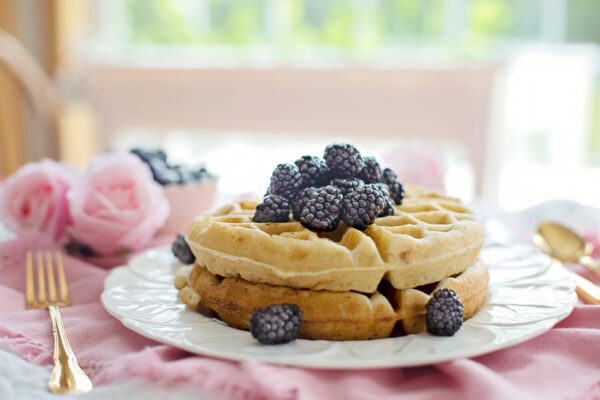
The history of the regular waffle dates back to the 10th century. It was first made in Belgium and enjoyed by the rich, who would use them as a way to show off their wealth. The waffles were served at lavish parties and eaten by hand.
The name “waffle” comes from the Old English word “waffel,” meaning “to move or to go.” Some historians believe this refers to how waffles are eaten: they are flipped over when they are cooked on one side so that you can eat both sides at once.
In the 15th century, King Louis XI of France outlawed the use of waffles because he believed they were eaten too much by peasants; however, this ban was lifted three years later by his successor Henry II.
In 1769, American colonists brought waffles to America from Europe; however, they did not become popular until around 1870, when someone figured out how to make them using a waffle iron!
History of the Belgian Waffle

The Belgian waffle is a type of waffle that started in Belgium and is traditionally made from leavened batter. It is made using a special iron that features four sections with deep grooves for holding the batter.
Dutchman Cornelius Van Houten invented the first known incarnation of the Belgian waffle in 1839. He used yeast instead of baking powder, which allowed his waffles to rise and have a better texture.
In 1842, another Dutchman named Joseph Liebermann created a machine that could make waffles faster and more efficiently than by hand. This led to mass production of Liebermann’s design across Europe, where many variations were created over time.
In the late 1800s, American immigrants brought their love for the Belgian waffle back home with them. The first US patent for a “waffle iron” was granted in 1861 to Eli Whitney Blake of Worcester, Massachusetts.
Differences Between Belgian Waffles and Regular Waffles
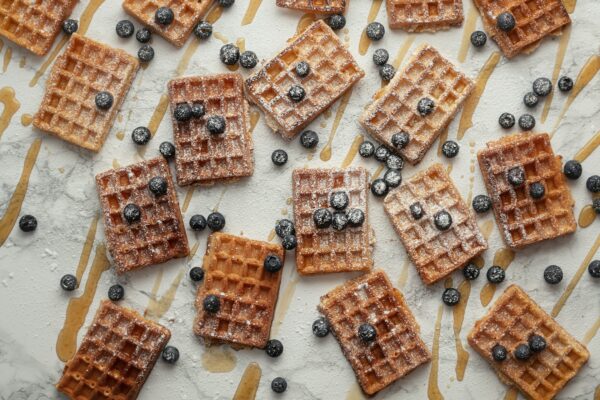
The difference between Belgian and regular waffles isn’t just in the shape or size.
The main difference is that Belgian waffles are made with a yeast batter, while regular American-style waffles are made with baking powder.
Belgian-style waffles are also typically cooked in a rectangular cast iron mold, which results in deeper pockets than you get from an American-style round cake pan.
This means your Belgian Waffle will have more room for toppings like chocolate chips or berries!
1. Difference in Appearance

When comparing Belgian waffles vs regular waffles, most people consider appearance. Belgian waffles are thicker and fluffier than typical American-style waffles, with a slight crispness on the outside. Regular waffles are usually thinner and denser than Belgian waffles, with a richer flavor.
You can pour more batter because Belgian waffles have deeper pockets than regular waffles.
Mostly, people prefer these waffles over standard American waffles because the larger pockets allow more toppings.
Belgian waffles can accommodate more syrup, fruit, whipped toppings, etc., than standard American waffles.
2. Difference in Recipes
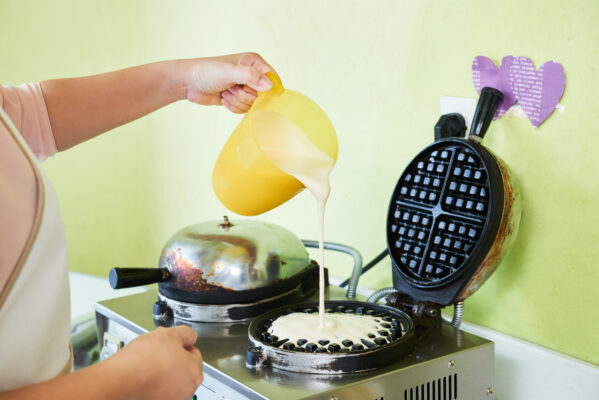
Belgian and regular waffles have a lot in common, but there are some key differences in the recipe.
The base ingredients for both waffles are similar: flour, milk, eggs, and butter.
But Belgian waffles have more milk and eggs than regular waffles, which gives them a richer taste. They also use yeast to provide them with that light and airy texture.
Regular waffles get their lightness from baking powder instead of yeast.
Belgian waffles also have more sugar in their batter than regular waffles—about twice as much—making them sweeter than regular waffles.
Regular waffles are made with baking powder, resulting in a fluffier texture, while Belgian waffles have more substance and are smaller in size.
3. Difference in Waffle Makers and Size

Waffle irons can vary widely, but they are all used in the same basic way; however, you will need a special Belgian-style waffle iron to make authentic Belgian waffles.
Belgian waffle makers have a deeper grid pattern than other types of waffle makers, allowing for iconic deep pockets.
Waffle makers are often round and require you to pour the batter into the device, close the lid, and flip the waffle maker over so it can cook.
A regular waffle maker usually opens and closes with a hinge, allowing the user to pour in the batter. The top of the waffle maker then heats up and cooks the Waffle.
Belgian waffle makers and ordinary waffle makers have their advantages and disadvantages. Belgian waffle makers produce fluffier, thicker, larger waffles than ordinary waffle makers.
In contrast, a regular waffle maker may not produce thick waffles, but it has more customization options. Further, you can use eggs, bread, and other items that are easy to cook on a grid.
4. Their Cooking Time Per Side
Belgian waffles are smaller, so they cook faster than regular waffles; you need to cook Belgian waffles for a shorter time per side and flip them more often than you would with their larger counterparts.
5. Their Toppings Of Choice Are Different
Belgian waffles are topped with a variety of ingredients, including chocolate, fruit, whipped cream, and powdered sugar. They’re also usually served with a side of pure maple syrup or butter.
Usually, its topping has butter and syrup, but you can top it with whatever you like!
Ways to Eat a Belgian Waffle

While the Belgian waffle is most commonly served with maple syrup and whipped cream, it can be eaten in several ways.
Here are some of the most common ways to eat a Belgian waffle:
- Plain – If you want to eat your waffle plain, there’s no need to add anything to it. You can just dip it in syrup or pour syrup over the top if you prefer.
- With Fruit – Belgian waffles are often served with fruit, like strawberries or blueberries. The fruit adds color, flavor, and texture to the dish.
- With Whipped Cream – Whipped cream is another popular topping for Belgian waffles. It adds both flavor and creaminess to the dish.
- With Ice Cream – Ice cream is yet another popular topping for Belgian waffles. You can get creative with different flavors of ice cream and different toppings like nuts or chocolate chips on top!
Ways to Eat a Regular Waffle
Waffles are a favorite breakfast food, but you can eat at any time.
Here are some common ways to eat a regular waffle:
- Toast it and spread peanut butter on it.
- Top it with syrup or jam.
- Make a sandwich with two pieces of bread and fill it with your favorite fruit or vegetables.
- Sprinkle cinnamon sugar on top and top with whipped cream or ice cream for dessert!
Can You Make Regular Waffles in a Belgian Waffle Maker?

Yes, you can easily make regular waffles in a Belgian waffle maker! The only difference is that you must adjust your cooking time and temperature.
When you use a Belgian waffle maker, it’s important to know the difference between a regular waffle and a Belgian waffle.
The main difference between the two is that the batter for Belgian waffles has more butter, which makes for a thicker batter that rises more during baking.
To achieve this same effect in your standard waffle maker, simply add more butter or oil to the batter—the extra fat will create a thicker batter that will rise more when cooked.
When making regular waffles in a Belgian waffle maker, it’s important not to overfill the wells with batter. If there isn’t enough space for steam to escape from underneath each well during baking, your waffles might stick together or burn on one side before being fully cooked on the other.
You should also check on your waffles regularly while cooking so that they don’t burn at all; if they seem like they’re taking too long or browning too quickly along one side, remove them immediately!
While you can use a Belgian waffle maker to make regular waffles, they might not turn out as well as if cooked in an ordinary electric or stovetop waffle iron.
Regular waffles will have a thicker batter that may not cook evenly from edge to center with this type of appliance.
If you want to make both types of waffles at home, consider purchasing an appliance with two kinds of settings built in—such as the Cuisinart Belgian Waffle Maker with Pancake Plates—or investing in two different machines for your kitchen.

Are Belgian Waffles Sweeter Than Regular Waffles?
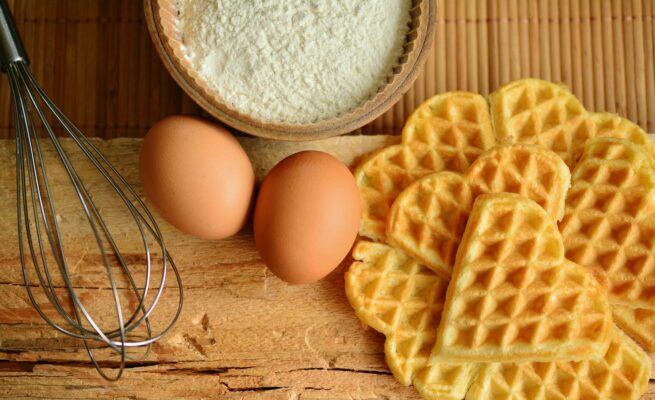
There is a type of Belgian waffle known as Liege waffles, which are sweeter than the original variety.
The Liege Belgian Waffle is named after the city of Liege in Belgium. They were invented by accident when a cook accidentally dropped some sugar into his waffle batter while cooking and found that he liked the result better than just plain waffles.
Liege waffles are made from yeast-leavened dough and have a darker color than other waffles.
In addition to the extra sweetness, Liege waffles have a different texture than regular waffles. They have a crunchy exterior and soft interior and are often served with powdered sugar or syrup as a topping.
What Makes Belgian Waffles Taste Different?

Belgian waffles are a delicious, sweet treat. They are pretty easy to make, and you can find their ingredients at most grocery stores.
But what makes Belgian waffles taste different from other kinds of waffles? The answer is in the batter.
The main difference between Belgian and American-style waffles is that they’re made with yeast instead of baking powder or soda.
The yeast gives Belgian waffles a richer flavor and makes them puff up more during cooking. This helps create pockets in the batter that give the waffle its distinctive texture: soft on the inside and crispy on the outside.
Belgian waffles also have a higher ratio of egg whites to yolks than American-style waffles, which means they don’t brown as much during baking.
The yolks make them fluffy and light, so if you like your waffle golden brown on top but light in color throughout (like those at [company name]), then Belgian ones might be what you’re looking for!
The key to making delicious Belgian waffles is using good-quality ingredients.
You’ll want to invest in a high-powered mixer if you plan on doing a lot of cooking or use an electric beater instead if you don’t have one available. You’ll also need to use fresh milk if possible—it makes all the difference!
Can You Make Belgian Waffles In a Regular Waffle Maker?

Yes, you can make Belgian waffles in a regular waffle maker.
Belgian waffles are made using a special type of batter thicker than regular waffle batter and more sugar. The sugar caramelizes during cooking, giving the waffle a much sweeter flavor than regular waffles.
To make Belgian waffles, simply follow the instructions in your recipe for making regular waffles, but add an extra 1/2 cup of flour to the dry ingredients and reduce the amount of milk by 3 tablespoons.
Also, add 3 tablespoons of sugar to the wet ingredients instead of 2 tablespoons. Use butter instead of vegetable oil when making the batter.
So, if you have a regular waffle maker and want to make Belgian waffles, you’ll need to use a special Belgian waffle iron.
These are the same size as your regular waffle iron but have higher ridges and deeper pockets. If you don’t have one of these, it’s not worth trying to make them unless you’re really into DIY projects or something!



